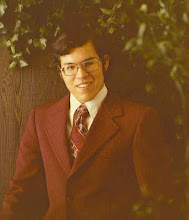When we were kids, my brother Mark and I made goofy home movies which spoofed James Bond, Superman, "Jaws", and horror movies. One of these teenage epics was called "The Plastic Blob." The Blob was just one of those thin, clear plastic sheathes that dry cleaners slip over suits. It made a perfect blob for several reasons: It was voluminous enough to pass as a large "thing" when shot at the right angle; when wadded up it really looked like a huge ameba, with endoplasmic reticulae and what-have-you; the thin material stayed wadded up, rather than "unfolded" as thick plastic does; it was so light that an off-screen fan would make it ooze along, and if left on the edge of a table or car roof, we could jump out of the way, start filming, and it would "flow" off with a natural-looking movement, like a living creature.
Anyway, we filmed "The Plastic Blob" one year during summer vacation, along with other deathless cinematic efforts like "The Glop Man" and "The Assassin." Then I graduated from high school and went to
I found the OSU Library to be a mind-expanding center of learning with its acres of floor space and its million-plus volumes. I would leave my dorm room and stay there until late at night -- often 'til one or two AM.
One night, probably in my Junior year, as I passed a wide parking lot on the way from the library to my dorm, I heard a soft hissing noise. Out in this parking lot, the wind -- which wasn't that strong -- was pushing along a large white mass. I recognized it as a plastic bag of the type put over suits at the cleaners. It made little impression on me, although it was certainly the largest object being pushed by the wind, and it was ghostly white in the darkness (of course, clear objects begin to look white when folded, wadded, or fissured, due to refraction).
Anyway, I was out late most week nights, and I always walked by or through that parking lot on the way back to my dorm. (It was a lot for professors and custodians, so few cars were parked there at night, although vehicles lined it on all four sides.) I kept seeing the plastic sheathe blowing from one side of the lot to the other, sometimes scooting under one side of a car and out the other. Sure, Styrofoam cups and little paper bags blew around too, but the "plastic blob" was large and eye-catching.
I supposed the janitorial services at OSU weren't efficient enough to catch all the detritus around the campus, but I found it odd the bag never blew away. The parking lot opened into another large lot on the west, and onto streets and open land on the north and east, but no matter which way the wind blew, the bag always stayed in this one lot. And the wind varied frequently -- at least, the bag was always sailing from one end to the other.
I reached the point where I watched for the plastic bag at night. I usually spotted it after hearing the hiss it made over the concrete. The way it billowed under or between cars made it look like a shy animal hiding from my approach. When it flowed in the same direction with other wind-blown trash, it looked like it was playing tag with empty paper cups and the like. I wondered why it never snagged on anything or got wedged under someone's tires. A plastic membrane that thin usually only has to touch a branch or something before it gets tangled like old cobwebs.
Finally one night came the culminating horror, or at least a sort of climax. At two AM, the library guardians kicked me out, and I walked through the cold, dark night toward my dorm. I took a short cut through the parking lot, staying near the line of parallel-parked vehicles on the south side.
I heard a hissing, scraping sound that I could not place at first. I caught movement out of the corner of my eye. I could see through the driver's side window of one parked car, across the front seat, and out the passenger's side. A large mass rose up into view on the passenger's side. It looked like someone had ducked down behind the vehicle and was just lifting their head up for a peek, except the "head" was clear/white. It was the plastic bag, wadded up. After a moment that really gave the impression of it "looking" back, it rolled up the passenger's window and flowed onto the roof with a "crinkly" sound. It flowed over to my side of the car and waited in a half-spread lump, like some predatory animal with its forelegs splayed, ready to pounce.
I wonder how many students were roused from slumber by my cry of "Holy _____! It really is the Plastic Blob!" Then I hurried away -- not quite running -- to my dorm. From then on, I took an alternate route to and from the library.
In these modern times, when plastic bags have essentially won out over paper (they don't even ask "Paper or plastic?" any more in the stores hereabouts), I have seen plenty of bags scooting along in the wind. I have seen small bags blown toward a car, scraping the ground all the way, which looked like they'd just slide under but instead swept up the side of the car high into the air, caught in some errant eddy. I've never seen anything that gave such an impression of deliberate movement, however, as the Plastic Blob. I can't help but wonder, too, if I would have found it so strange -- or even have noticed the bag in the first place -- if my brother and I had not made that short 8mm film. Go figure.

